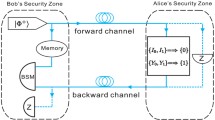Abstract
The crucial issue of quantum communication protocol is its security. In this paper, the security of a secure direct communication based on ping-pong protocol [Chamoli A, Bhandari CM, Quantum Inf Process 8, 347 (2009)] is analyzed. It is shown that in this protocol any dishonest party can obtain all the other one’s secret message with zero risk of being detected by using a special type of attack, i.e., using fake entangled particles (FEP attack). Finally, a simple improvement to resist this attack is proposed.
Similar content being viewed by others
References
Bennett, C.H., Brassard, G.: Quantum cryptography: public-key distribution and coin tossing. In: Proceedings IEEE International Conference on Computers, Systems, and Signal Processing, Bangalore, pp. 175–179. IEEE, New York (1984)
Ekert A.: Quantum cryptography based on Bell’s theorem. Phys. Rev. Lett. 67, 661 (1991)
Bennett C. H.: Quantum cryptography using any two nonorthogonal states. Phys. Rev. Lett. 68, 3121 (1992)
Nielsen M. A., Chuang I. L.: Quantum computation and quantum information. Cambridge University Press, Cambridge (2000)
Beige A., Engler B. G., Kurtsiefer C., Weinfurter H.: Secure communication with a publicly known key. Acta. Phys. Pol. A 101, 357 (2002)
Bostrom K., Felbinger T.: Deterministic secure direct communication using entanglement. Phys. Rev. Lett. 89, 187902 (2002)
Nguyen B. A.: Quantum dialogue. Phys. Lett. A 328, 6–10 (2004)
Wen X.J. et al.: Secure quantum telephone . Opt. Commun. 275, 278–282 (2007)
Sun Y. et al.: Improving the security of secure quantum telephone against an attack with fake particles and local operations. Opt. Commun. 282, 2278–2280 (2009). doi:10.1016/j.optcom.2009.02.033
Naseri M.: Eavesdropping on secure quantum telephone protocol with dishonest server. Opt. Commun. 282, 3375–3378 (2009). doi:10.1016/j.optcom.2009.05.012
Jin X. R. et al.: Three-party quantum secure direct communication based on GHZ states. Phys. Lett. A 354, 67 (2006)
Deng F. G. et al.: Multiparty quantum secret report. Chin. Phys. Lett. 23, 1676–1679 (2006)
Naseri M.: Secure quantum sealed-bid auction. Opt. Commun. 282, 1939–1943 (2009)
Chamoli A., Bhandari C. M.: Secure direct communication based on ping-pong protocol. Quantum Inf. Process. 8, 347 (2009)
Li X. H. et al.: Deterministic secure quantum communication without maximally entangled states. J. Korean Phys. Soc. 49, 1354 (2006)
Li C. Y. et al.: Secure quantum key distribution network with Bell states and local unitary operations. Chin. Phys. Lett. 22, 1049–1052 (2005)
Author information
Authors and Affiliations
Corresponding author
Rights and permissions
About this article
Cite this article
Naseri, M. Comment on: “secure direct communication based on ping-pong protocol” [Quantum Inf. Process. 8, 347 (2009)]. Quantum Inf Process 9, 693–698 (2010). https://doi.org/10.1007/s11128-009-0157-2
Received:
Accepted:
Published:
Issue Date:
DOI: https://doi.org/10.1007/s11128-009-0157-2




